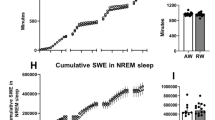Abstract
The purpose of this study was to develop a laboratory animal model of human shift work. Two methods of monitoring circadian rhythms in rats were employed: an activity wheel cage, where number of wheel revolutions (WR) were counted, and an internal radio transmitter, which recorded gross motor activity (GMA) and body temperature (BT). Rats were implanted with biotelemetry transmitters that detected GMA and BT and were placed in activity wheel cages. A 12 hour/12 hour light/dark cycle was maintained. Subjects were subdivided into two groups: control and experimental. Following a habituation period of 15 days, in which animals had ad-libitum access to food and water and unlimited access to the running wheel, the experimental period ensued for 22 days. Control animals were food restricted and their activity wheels were locked during the light; experimental animals were food restricted and their activity wheels were locked during the dark. At the end of the experimental period, animals were returned to the habituation paradigm for 15 days. Recordings of WR, GMA and BT, as well as daily monitoring of body weight and food intake, indicated that experimental animals resembled humans employed in a shift work schedule. In the experiment, the light entrainable oscillator and the food entrainable oscillator were uncoupled in experimental animals, producing alterations in activity/rest cycles, consummatory behavior, and overt behavior. Since similar alterations occur in shift workers, it is proposed that the experimental paradigm presented in this manuscript is a useful model of shift work and provides a framework upon which future experiments may be conducted.
Similar content being viewed by others
References
Äkerstedt, T. (1984). Work schedules and sleep.Experientia, 40:417–422.
Äkerstedt, T. (1988). Sleepiness as a consequence of shift work.Sleep, 11:17–34.
Äkerstedt, T. (1990). Psychological and psychophysiological effects of shift work.Scandinavian Journal of Work, Environment & Health, 16:67–73.
Balagura, S. (1975). Effect of light-dark cycle on neuroendocrine and behavioral responses to scheduled feeding.Physiology & Behavior, 15:245–247.
Costa, G. (1996). The impact of shift and night work on health.Applied Ergonomics, 27:9–16.
Czeisler, C. A., M. P. Johnson, E. N. Brown, J. M. Ronda & R. E. Kronauer. (1990). Exposure to bright light and darkness to treat physiologic maladaptations to night work.The New England Journal of Medicine, 322:1253–1259.
Edery, I. (2000). Circadian rhythms in a nutshell.Physiological Genomics, 3:59–74.
Holmback, U., A. Forslund, J. Forslund, L. Hambraeus, M. Lennernäs, A. Lowden, M. Stridsberg & T. Äkerstedt. (2002). Metabolic responses to nocturnal eating in men are affected by sources of dietary energy.Journal of Nutrition, 132:1892–1899.
Greenwood, B. N., T. E. Foley, H. E. W. Day, J. Campisi, S. H. Hammack, S. Campeau, S. F. Maier & M. Fleshner. (2003). Freewheel running prevents learned helplessness/behavioral depression: role of dorsal raphe serotonergic neurons.The Journal of Neuroscience, 23:2889–2910.
Labyak, S. (2002). Sleep and circadian schedule disorders.The Nursing Clinics of North America, 37:599–610.
Lamberg, L. (1994).Bodyrhythms: Chronobiology and Peak Performance (1st ed.). New York: Morrow.
Lennernäs, M. & I. Andersson. (1999). Food-based classification of eating episodes (FBEC).Appetite, 31:53–65.
Knutsson, A., B. Karlsson, K. Ornkloo, U. Landstrom, M. Lennernäs & K. Eriksson. (2002). Postprandial responses of glucose, insulin and triglycerides: influence of the timign of meal intake during night work.Nutrition and Health, 16:133–141.
Maas, J. (1998).Power Sleep. New York: Villard.
Mistlberger R. E. (1991). Effects of daily schedules of forced activity on free-running rhythms in the rat.Journal of Biological Rhythms, 6:71–80.
Mistlberger, R. E. (1994). Circadian food-anticipatory activity: formal models and physiological mechanisms.Neuroscience Biobehavioral Review, 18:171–195.
Moore, R. Y. (1997). Circadian rhythms: basic neurobiology, and clinical applications.Annual Review of Medicine, 48:253–266.
Moore-Ede, M. (1993).The Twenty Four Hour Society. Massachusetts: Addison-Wesley Publishing Company.
Moraska, A., T. Deak, R. L. Spencer, D. Roth & M. Fleshner. (2002). Treadmill running produces both positive and negative physiological adaptations in Sprague-Dawley rats.American Journal of Physiology-Regulatory, Integrative and Comparative Physiology, 279:R1321-R1329.
Murphy, H. M., C. H. Wideman & G. R. Nadzam (1993). Vasopressin deficiency and circadian rhythms during food-restriction stress.Peptides, 14:1215–1220.
Murphy, H. M., C. H. Wideman & G. R. Nadzam. (1996). The interaction of vasopressin and the photic oscillator in circadian rhythms.Peptides, 17:467–475.
Murphy, H. M., C. H. Wideman & G. R. Nadzam. (1998). The role of vasopressin in modulating circadian rhythm responses to phase shifts.Peptides, 19:1191–1208.
Oudot, F., C. Larue-Archagiotis, G. Anton & P. Verger. (1996). Modifications in dietary self-selection specifically attributable to voluntary wheel running and exercise training in the rat.Physiology & Behavior, 59:1123–1128.
Reinberg, A. (1993). Chronobiology and nutrition. In A. Reinberg and M. H. Smolensky (Eds.),Biological Rhythms in Medicine. New York: Springer-Verlag.
Ribeiro, D. C. O., S. M. Hampton, L. Morgan & J. Arendt. (1998). Altered postprandial hormone and metabolic responses in a simulated shift work environment.Journal of Endocrinology, 158:305–310.
Roky, R., L. Kapas, P. Taishi, J. Fang & J. M. Krueger. (1999). Food restriction alters the diurnal distribution of sleep in rats.Physiology & Behavior, 67:697–703.
Stewart, A. J. & M. L. Whalqvist. (1985). Effect of shiftwork on canteen food purchase.Journal of Occupational Medicine, 27:552–554.
Turek, F. W. (1994). Circadian rhythms. In C. W. Bardin (Ed.),Recent Progress in Hormone Research, vol. 49. San Diego: Academic Press Inc.
Yancey, S. L. & J. M. Overton. (1993). Cardiovascular responses to voluntary and treadmill exercise in rats.Journal of Applied Physiology, 75:1334–1340.
Author information
Authors and Affiliations
Rights and permissions
About this article
Cite this article
Murphy, H.M., Wideman, C.H. & Nadzam, G.R. A laboratory animal model of human shift work. Integrative Physiological & Behavioral Science 38, 316–328 (2003). https://doi.org/10.1007/BF02688860
Issue Date:
DOI: https://doi.org/10.1007/BF02688860




